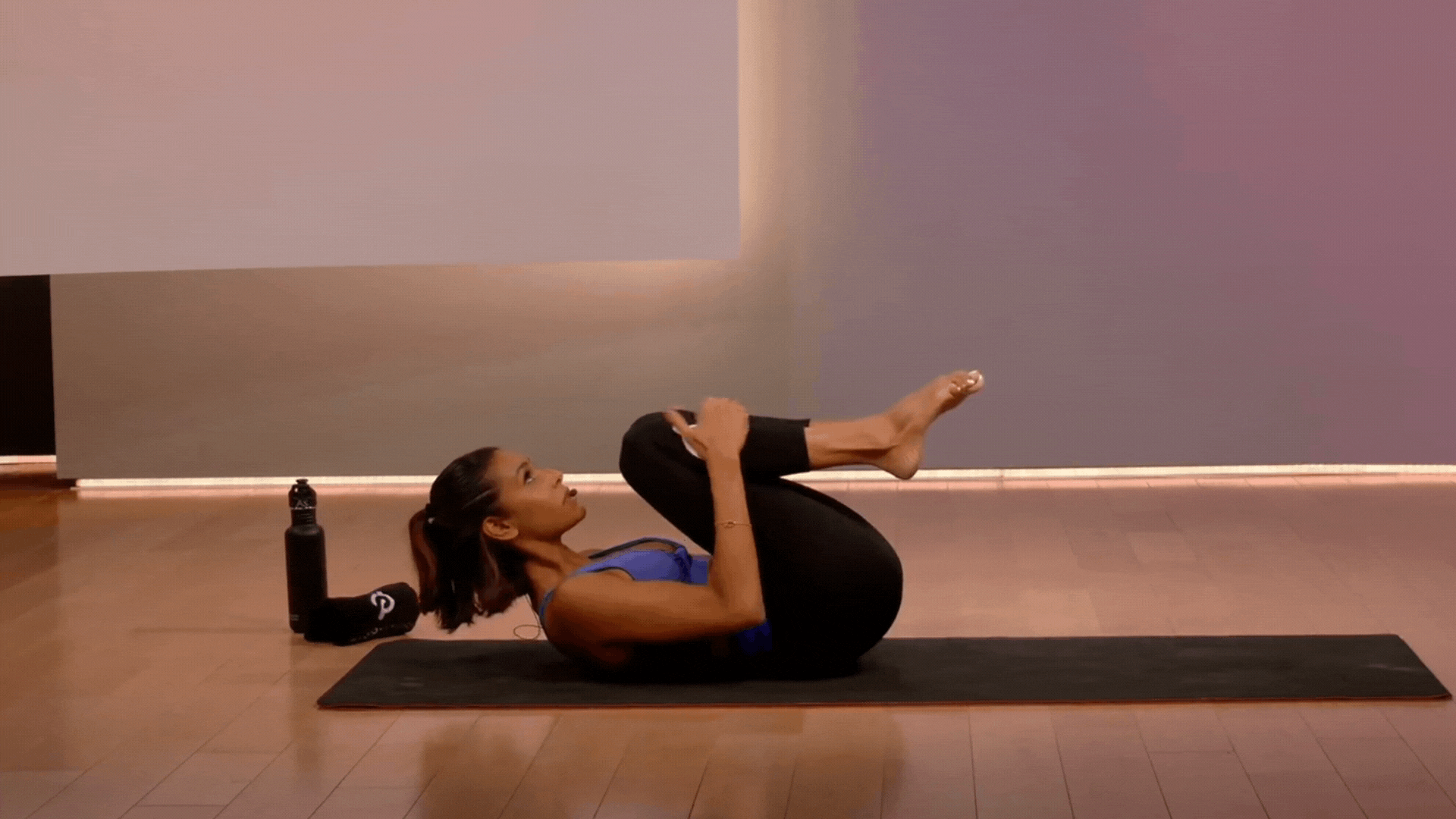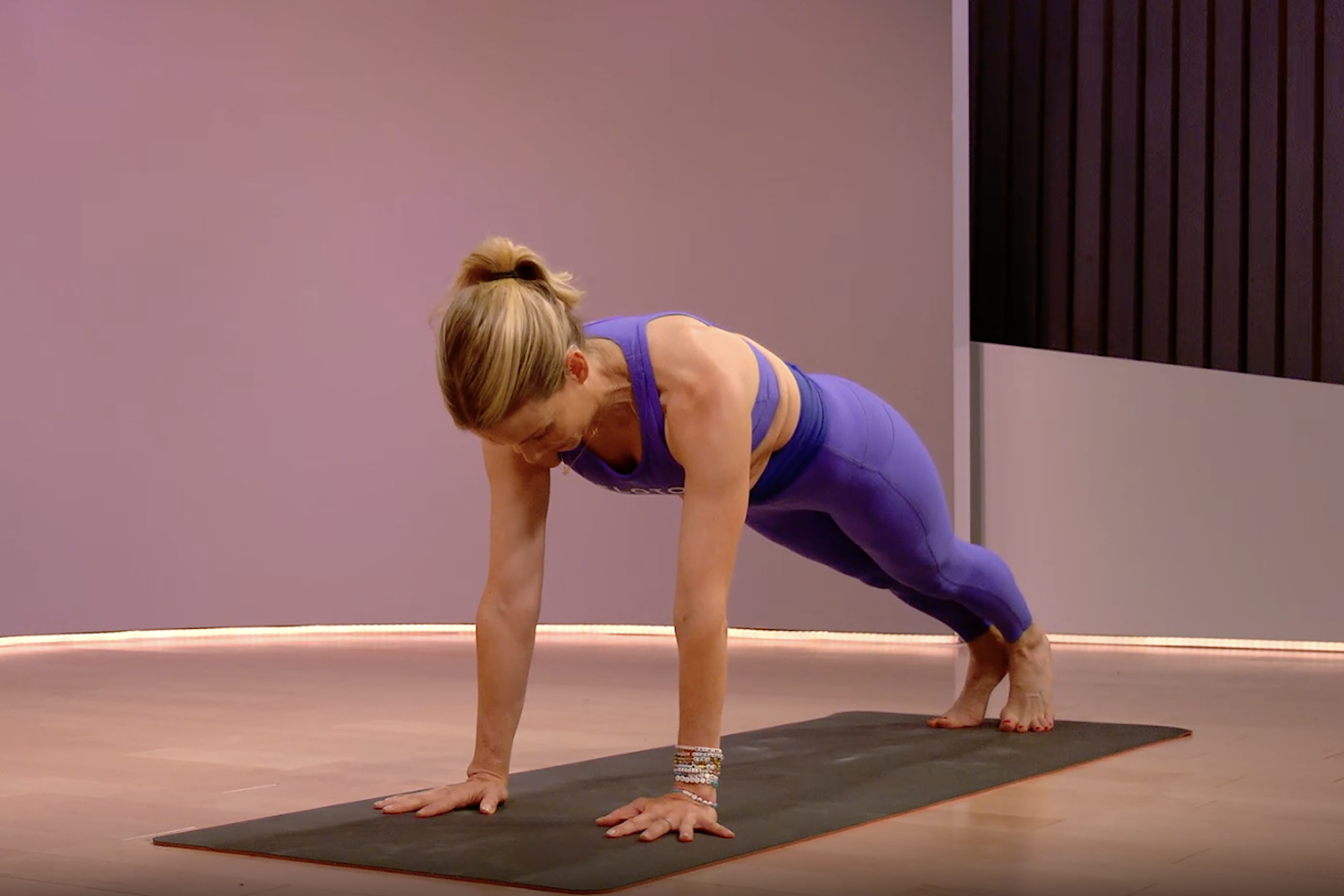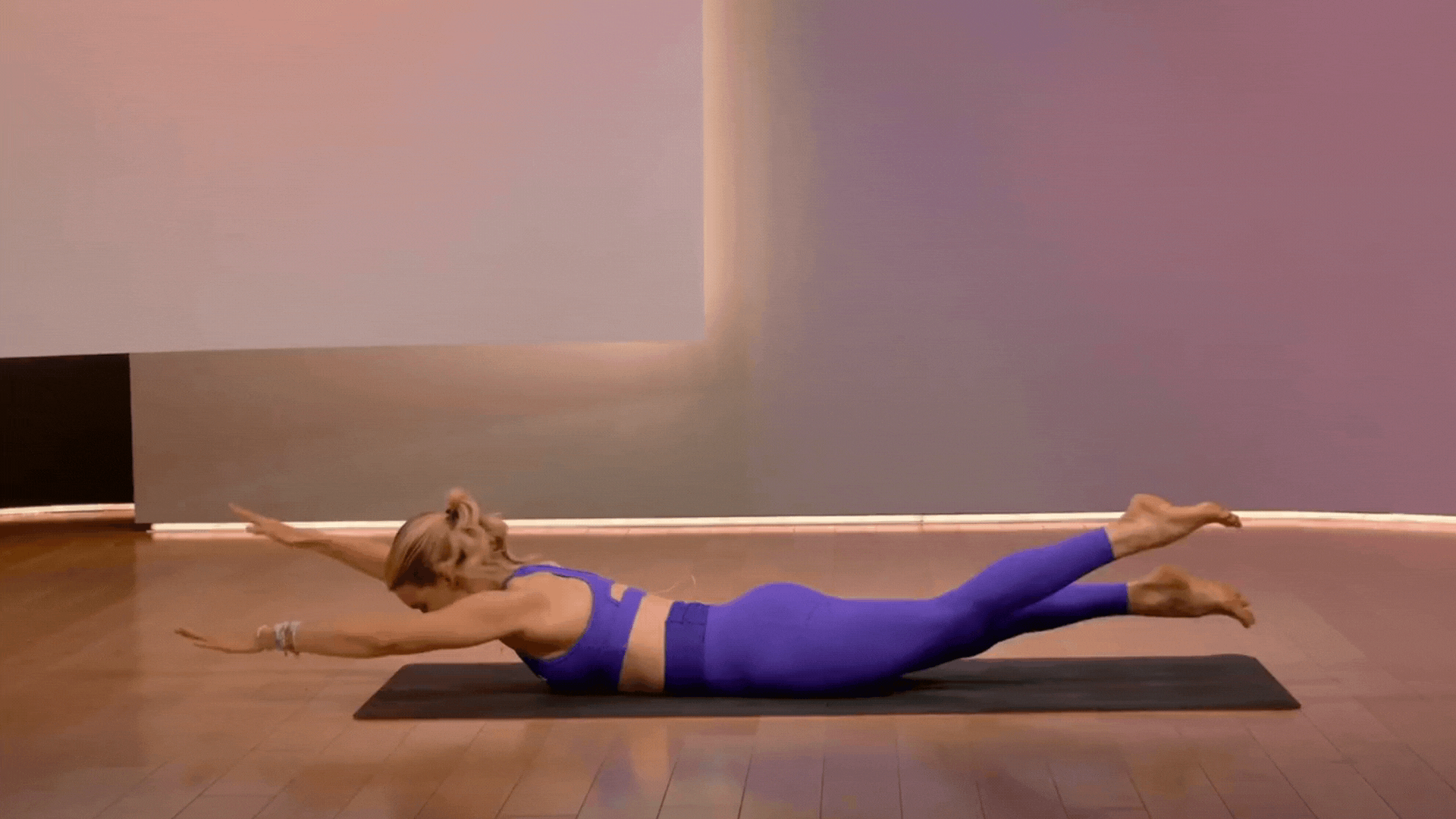
Mat Pilates Is Having Its Renaissance Moment: Here’s How To Join In
There’s a reason this workout has stood the test of time.
By Michele Ross•
What Is Mat Pilates?
What’s the Difference Between Pilates and Other Workout Types?
Mat Pilates Benefits
What You Need for Mat Pilates
Pilates Mat Exercises for Beginners
How to Get Started with Mat Pilates
New to the world of mat Pilates? To paraphrase an often-shared quote from founder Joseph Pilates, this workout has the potential to help you feel better in 10 sessions, look better in 20 sessions, and yield a completely new body in 30 sessions. But it won’t only help to get (or keep) you in shape; it also offers benefits for your posture, flexibility, and mental health.
In this comprehensive guide, you’ll discover what sets mat Pilates apart from similar workouts and the biggest benefits it stands to offer. Plus: a list of foundational Pilates moves and how to do them, guided by your favorite Peloton instructors.
What Is Mat Pilates?
“Pilates is a very precise practice that aims to organize the body and optimize its movements,” says Peloton instructor Anna Greenberg. The low-impact modality is famed for its focus on core strength, yet it promotes healthy ranges of motion within the entire body.
Founded by German physical trainer and inventor Joseph Pilates in the early 20th century, the mind-body practice follows six principles:
Breath
Concentration
Centering
Control
Precision
Flow
About 50 moves designed by Joseph Pilates himself comprise the groundwork for most modern-day Pilates mat Pilates classes. “Over time, instructors have varied the choreography—but traditionally speaking, his mat work is a set guide laid out by him after years of experience,” shares Peloton instructor Kristin McGee. Moves can be modified for equipment-based Pilates, such as the Pilates Reformer, or with other traditional studio apparatuses like the Cadillac or Chair. “The Reformer and his equipment follow the same principles, but incorporate different choreography to fit the machines,” Kristin explains.
What’s the Difference Between Pilates and Other Workout Types?
While Pilates, yoga, and barre often tend to get grouped together and can very well complement each other, they’re not interchangeable. “Though all three modalities have incredible benefits, they serve different purposes and have different origins,” notes Peloton instructor Aditi Shah. “Yoga is first and foremost a philosophical practice with many different lineages. The movement portion, or asana practice, is a tiny element of the myriad of different ways we can engage with yoga.” In fact, the physical fitness aspect of yoga is only one of the eight limbs of yoga set forth in the Yoga Sutras of Patanjali, an ancient Sanskrit text on yoga theory and practice. Yoga “has an entire spiritual system that goes with it, from pranayama (breath work) to meditation and ethical practices,” Kristin adds.
Lastly, barre blends elements of ballet, yoga, and Pilates. It prioritizes high reps of movements with small ranges of motion often performed alongside a traditional ballet barre. Kristin notes that barre classes are usually led to the beat of the music and employ a tucked pelvis position, whereas mat Pilates calls for a neutral pelvis.
Mat Pilates Benefits
If you’re looking for a low-impact exercise modality that’s accessible, requires little equipment, and builds strength while helping you form a connection with your body, look no further than mat Pilates. These are just a few of the many benefits of mat Pilates:
1. It Blends Strength and Flexibility
When you mindfully execute foundational Pilates moves, you’ll notice yourself getting stronger, sculpted, and more agile. In fact, Kristin believes mat Pilates to be the gold standard not only to build strength but also to know how to effectively engage the right muscles. “You'll gain strength and flexibility while learning how to move from your center. You'll find a new way to move from your powerhouse—the deep core muscles—and work smarter, not harder,” she shares. Better yet, she says it’s entirely possible to enjoy yourself while you’re at it.
2. It Promotes Postural Alignment
According to a 2011 review in the journal Sports Health, “One of the key Pilates techniques to align, lengthen, and protect the spine is to draw the navel to the spine.” This helps with core stability and engagement. Plus, Kristin says that “your posture will improve and you'll feel like you can move much easier” both on and off your mat.
3. It Facilitates Mind-Body Awareness
All three Peloton instructors praise mat Pilates for its ability to help you feel your best through mindful techniques and functional movements. “Practicing mat Pilates can help you move with greater strength, ease, and awareness in everything you do,” Anna says. “If you think of your body as an instrument, practicing Pilates is like giving it a tune-up and making every part work harmoniously together.”
4. It Supports Mental Health and Boosts Vitality
Pretty much any form of physical activity can benefit your mental health, with mat Pilates included. In a 2020 study of 87 young adult men, those who completed a 30-minute mat Pilates class reported significant improvements in anxiety, fatigue, and overall mood disturbances. A 2015 review also found that Pilates can improve mood, sense of independence, and quality of life in mature adults.
5. It Helps Reduce Pain
While mat Pilates surely counts as a workout, it’s also employed for rehabilitation purposes and to improve physical function. The low-impact, restorative nature of the practice promotes benefits for those seeking active forms of recovery and pain management. Per a 2022 review in Musculoskeletal Care, Pilates is “significantly effective” for reducing back, neck, and knee pain in older adults suffering from chronic musculoskeletal conditions.
6. It Promotes a Healthy Lifestyle and Is Suitable for All
Mat Pilates is a low-risk, high-reward modality for well-being. It’s safe and effective for everyone—from complete Pilates beginners and cycling aficionados to mature adults and those who might otherwise follow a sedentary lifestyle. “Anyone can do Pilates. There are so many ways to modify every movement, [with] variations that allow us to bear weight only where it feels safe,” says Aditi. “It's a wonderful practice in that it really suits every kind of body.”
In addition, research also shows that those who practice Pilates and/or yoga are more highly engaged in health-promoting behaviors. Simply put, the benefits of Pilates go beyond your practice on the mat and can carry on not only throughout your day but throughout your life.
What You Need for Mat Pilates
One of the biggest perks of mat Pilates is that you can pretty much do it whenever and wherever. That said, a few things can make your practice more comfortable—or even more challenging, if that’s what you’re aiming for.
Naturally, a mat should be the first thing to keep on hand for your workout. Additional Pilates equipment that can enhance your practice includes:
Grip socks
A Pilates ball
A Pilates ring (aka a “magic circle”)
Sliders
A workout towel
A yoga strap
Resistance bands
Ankle weights
Pilates Mat Exercises for Beginners
These are a few of Peloton Pilates instructors Anna, Kristin, and Aditi’s favorite moves. Try them all, or add a few into your next workout for a taste of what Pilates has to offer.
1. Hundreds
Targeting your abs, arms, and glutes, hundreds are perhaps the most famous Pilates exercises for beginners and advanced practitioners alike.

A. Lay on your back and bend your knees up to a table top position. Stretch your arms forward and lift your head and neck up off the mat, engaging your core.
B. Keep legs bent or extend them at a 45-degree angle, with heels together and toes slightly turned out.
C. Pump your arms from your triceps and lats. Inhale for five counts and exhale for five counts. Repeat the cycle for 10 reps to complete 100 pumps.
2. Double Leg Stretch
This Pilates move simultaneously targets your deep core, arms, and legs.

A. Lay on your back and hug your knees into your chest. Lift your head and neck from the mat.
B. Inhale as you extend your arms and legs away from each other, taking care not to let your head and neck drop.
C. Exhale as you make a “snow angel” motion with your arms and bend your knees back into the starting position, engaging your core even more.
3. Plank
A high plank is a full-body exercise that’s sure to get you shaking the longer you hold it—but the more you do it, the longer you’ll be able to hold it and the stronger you’ll get.

A. Place palms or forearms on the ground with a neutral pelvis and your core and legs active.
B. Keep your body as flat as a wooden plank with your heart open and your gaze slightly forward to keep your spine straight.
4. Leg Circles
Leg circles will work your legs and core as well as promote more mindful awareness of how you move your body. “I always say it's not about lifting your leg; it's about how you lift your leg,” Aditi emphasizes.

A. Lay on your back. Keep one leg extended or bent on the ground as you bring the other leg straight up toward the ceiling.
B. Make controlled circles (big or small) with the straight leg without rocking the hips, pelvis, or lower back. Repeat leg circles in the opposite direction then switch sides.
5. Teaser
Targeting your deep core, the teaser is another classic Pilates exercise.

A. Lay on your back with your arms and legs extended.
B. Inhale up to a “V” shape with your arms reaching towards (but not touching) your toes, lifting out of your lower back and engaging your deep core. Aim to move the arms and legs at the same time.
C. Exhale as you lower your body to the mat in a controlled, even motion.
6. Toe Taps
Sure to fire up your core, toe taps are among Aditi’s favorite Pilates moves.

A. Lay on your back with legs bent in a tabletop position and a neutral pelvis. Keep your arms by your side or towards the ceiling.
B. Maintain a 90-degree angle in your legs and stabilize the pelvis and lower back as you tap your toes on the floor before bringing them back to tabletop.
“If the hip flexors feel overactivated, modify by collapsing the legs,” Aditi advises. To spice things up, she suggests curling the head, neck, and shoulders off the mat as you do your toe taps.
7. Criss Cross
This exercise is a Pilates version of a bicycle crunch, working your abs (and the obliques in particular).

A. Lay on your back with your arms behind your head.
B. Lift one elbow or armpit towards the opposite knee, alternating sides in a slow and controlled motion while keeping your core engaged.
8. Swimming
According to Kristin, this mat Pilates exercise targets the glutes, lats, arms, abs, and the posterior chain.

A. Lay on your stomach with arms extended in front of you.
B. Lift your body from the mat, drawing your lower abs in and up.
C. Lift one arm and the opposite leg higher than the other, alternating sides to make a “swimming” motion while keeping the torso still.
9. Articulating Bridge
“This exercise mobilizes the spine, activates the low abdominals and hip extensors and is a wonderful way to increase proprioception by articulating through each vertebra with intention,” Anna explains.

A. Lay on your back with knees bent, feet flat on the floor, and a neutral pelvis.
B. Curl your tailbone towards the backs of your thighs as you lift your spine from the mat one vertebra at a time.
C. Inhale once you reach the top of the bridge. Retrace your steps rolling down through each section of your spine. Release your tailbone once your back is on the mat and return to a neutral pelvis.
10. Knee Stirs
“This move mobilizes the hips in the most gentle and satisfying way,” Anna shares.

A. Lay on your back with a neutral spine and pelvis. Bend your knees and hold onto them with your shins and feet relaxed.
B. Slowly stir your knees in a circular motion, allowing your femur bones to release deep into your hip sockets. Repeat in the opposite direction.
How to Get Started with Mat Pilates
Now that you’re familiar with the basics and benefits of mat Pilates, it’s time to kick off your home practice. Remember, anyone and everyone can fit Pilates into their routines for mind-body benefits, and you can tailor the moves to your body’s needs. Tip: Choose from a range of mat Pilates classes on the Peloton App to find the best routine for your body and your needs.
Last but not least, the Peloton instructors share a few parting tips as you get started with mat Pilates:
Try a beginner class to nail down the basics.
“Make sure you're breathing in class and work on lateral breathing (side to side) on the inhale and engaging the deep core on the exhale,” Kristin advises.
Prioritize form above all. Kristin notes that six to eight precise moves will be safer and more effective than 20 sloppy ones.
Trust in the practice. “I think of Pilates as a quiet storm as opposed to other strength workouts that feel louder and more explosive, but that doesn’t mean it isn’t incredibly effective,” Anna shares. Instead, she says that mat Pilates exercises (and the core ones in particular) will sneak up on you and create a satisfying burn.
Stick with it, even if it’s challenging as a beginner. “It takes time and repetition to understand the movements and to feel embodied within the practice,” Aditi explains. Just remember that your efforts will pay off the more you do it.

Peloton App
Access thousands of classes with no equipment needed.
This content is for informational and educational purposes only and does not constitute individualized advice. It is not intended to replace professional medical evaluation, diagnosis, or treatment. Seek the advice of your physician for questions you may have regarding your health or a medical condition. If you are having a medical emergency, call your physician or 911 immediately.
Level up your inbox.
Subscribe for a weekly dose of fitness, plus the latest promos, launches, and events.
By providing your email address, you agree to receive marketing communications from Peloton.
For more about how we use your information, see our Privacy Policy.


